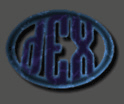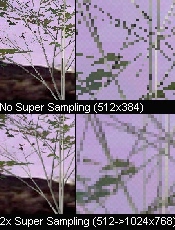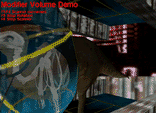 | ||||||||||||
|
 |
|
...So what more features does this chipset contain?
Up The Rez
 Ok, maybe you've heard some babble about 'super sampling.' Somewhere I read that the Katana would render internally at resolution X, then scaled to the correct output resolution for the monitor. This is super sampling. NEC defines it as such: Image is rendered to a specified resolution and then is scaled to the users view port using a bi-cubic filter (similar to Photoshop). The effect of the function is similar to anti-aliasing, except it works much better as the full scene is covered instead of specified edges. The PowerVR supports output resolutions of up to 1600x1200 pixels, and internally up to 2048x2048 pixels. The performance hit comes in a lowered fill rate, but not enough so that using the super-sampling vs. a higher resolution is slower.
Ok, maybe you've heard some babble about 'super sampling.' Somewhere I read that the Katana would render internally at resolution X, then scaled to the correct output resolution for the monitor. This is super sampling. NEC defines it as such: Image is rendered to a specified resolution and then is scaled to the users view port using a bi-cubic filter (similar to Photoshop). The effect of the function is similar to anti-aliasing, except it works much better as the full scene is covered instead of specified edges. The PowerVR supports output resolutions of up to 1600x1200 pixels, and internally up to 2048x2048 pixels. The performance hit comes in a lowered fill rate, but not enough so that using the super-sampling vs. a higher resolution is slower.
Volume Mods
 Ok, so the chip does volume modifiers. What's that do for me? This feature is an extension to light and shadow volumes. Lets say you have two objects. A cloaked spaceship passing through a nebula of some sort. The spaceship is a regular object, while lets say the nebula has the volume modifier property. When the spaceship is inside the nebula, you can assign a graphic way in which it is effected. Say, its cloaking starts to fail when its inside, revealing the hidden ship. Here you'll see a volume modification demo with an x-ray effect. I've reduced the colors from full color to 64 to keep the file size down (3frame animated gif).
Ok, so the chip does volume modifiers. What's that do for me? This feature is an extension to light and shadow volumes. Lets say you have two objects. A cloaked spaceship passing through a nebula of some sort. The spaceship is a regular object, while lets say the nebula has the volume modifier property. When the spaceship is inside the nebula, you can assign a graphic way in which it is effected. Say, its cloaking starts to fail when its inside, revealing the hidden ship. Here you'll see a volume modification demo with an x-ray effect. I've reduced the colors from full color to 64 to keep the file size down (3frame animated gif).
Specs Overview:
- 2D/3D solution on 1 chip.
- Deferred rendering of 120 Mpixels per second.
- 1.2 million front facing, fully textured, lit and shadowed polygons per second. With a peak rate of three million to four million polygons per second.
- Geometry can be triangles, quads, polygon strips and fans.
- Full CPU load balancing.
- Tile accelerator.
- Full floating-point geometry and texture setup engine.
- Performance that scales up with faster CPUs.
- 32-bit accurate floating point Z-buffering with no RAM accesses.
- Unified frame buffer and texture memory.
- Stencil buffer.
- VQ (vector quantization) texture compression with up to 8:1 compression ratios (operates in real time).
- 2X AGP with sidebands and PCI (33MHz/66MHz).
- Full alpha blending modes supported.
- Image super-sampling for full scene anti-aliasing.
- Perspective correct bilinear, trilinear, and anisotropic texture filtering.
- Perspective correct ARGB gouraud shading.
- Specular highlighting with offset colours.
- Environment mapping.
- Hardware translucency sorter.
- Volumetric effects (shadows, lens flare, etc).
- Multiple fog modes.
- Bump mapping.
- Full DirectX and OpenGL blending modes (back-end multi-pass rendering with Micro-tile accumulation buffers).
- 3D in a Window.
- Max resolution of 1600 by 1200 in 24 bit color.
- 100MHz clock rate, RAMDAC (230Mhz).
- Manufactured in NEC's leading 0.25-micron process.
- 2 to 32MB of 100 MHz SDRAM.
- MPEG 2 decode.
- DVD-assist.
- Video IN and OUT.
- Full support for DirectX 6, which is due this July.
Chipset Arrival: Now To Developers, Summer '98 to Consumers.
Estimated Cost: $30/chip in 10,000 unit lots.
Ok, so there you have it, the dEX PVRSG technology overview. I've left out some things, but you should be able to find more information on the source sites listed below. Later this week on May 21st, Sega of Japan will have a formal announcement regarding its next console. Then we shall see how this great chipset relates to the console.
Sources: PowerVR and VideoLogic. And PowerVR Global. Glossary terms can be found at: Next Generation Lexicon.
All products are trademarks of their respective companies.
Questions or comments? Contact dEX.